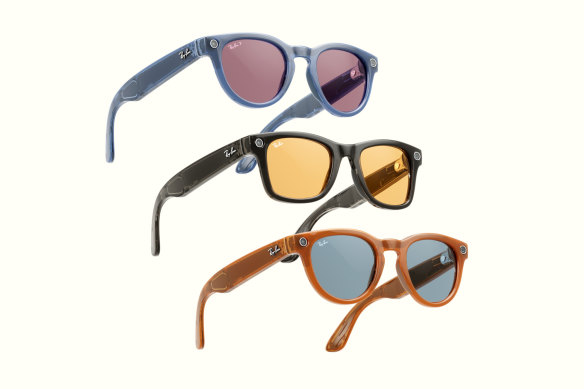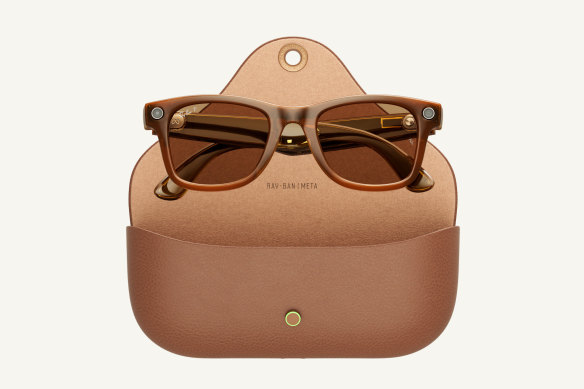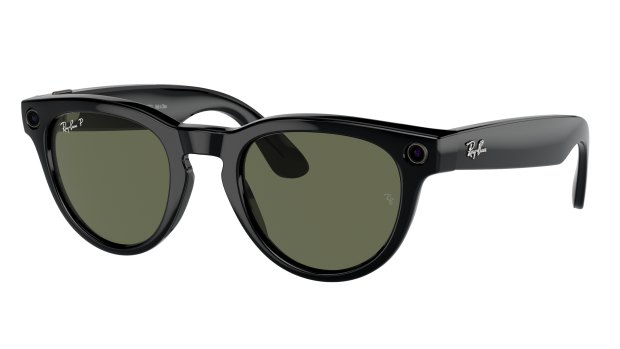- Review
- Technology
- Gadgets
Is the Ray-Ban Meta mash-up worth putting on your face?
By Tim Biggs
Like virtual reality headsets and AI voice assistants, smart glasses are something we’ve seen for so long in science fiction that our expectations (and fears) tend to run ahead of the actual experience, and leave us a little disappointed.
But while Facebook-owner Meta’s collaboration with Ray-Ban doesn’t deliver personal video screens and X-ray scanners, the glasses are surprisingly useful.
Essentially, they take certain elements of your phone and put them conveniently on your face. You can take videos or pictures in situations where your hands are full or your phone is a few steps away, make and receive calls, and you can also listen to music and podcasts on the go, without bothering about earbuds.
At some point in the near future, the glasses will also double as a personal assistant as Meta AI (which works with the smart glasses in North America, but not yet in Australia) can access the camera feed to interpret text for you, or answer your questions about landmarks and anything else you can see.
A camera near your eyes
Most models of the Ray-Ban Meta glasses look completely ordinary, and that’s a genius move. Some people might like to look like they’re wearing a computer on their face (and for them, there are transparent models), but I’d wager the majority want regular-looking glasses, and these come in the well-established Ray-Ban silhouettes of Wayfarer, Headliner or Skyler.
When you buy the glasses, which start at $450 but go up for certain styles and finishes, you can choose whatever polarisation or prescription lenses you want, meaning they function just like regular glasses. (Though Meta says having different lenses fitted after the fact could void your warranty.) If possible, you might want to visit a store and try them on first, as they are a bit heavier than regular Ray-Bans, and though the arms are stiff and cling to your face they may slip down your nose more than you expect.

Transparent models make for a much more tech-forward look.
On the left edge of the frame sits an HD camera, and on the other side is a shutter button for taking photos or recording clips. It takes some practice to frame things up blind, and if you have long hair you have to make sure you brush it out of the way, but the results are generally nice and sharp.
It’s a wider lens than your standard main camera on a phone and it’s locked in vertical orientation, but since it’s on your face it gives you the ability to snap pictures instantly or if your phone’s not at hand. Taking a picture of a restaurant menu as you pass to look at later, for example, or capturing your kids or your cat in a video without spooking them.
The images you take move from the glasses to your phone via Bluetooth, and are stored in the rather spartan Meta View app, from which you can save or share them.

Meta says the glasses last for four hours on a charge, but I’d say they last longer. They come with a battery case that can store around 36 hours worth of juice.
You can also use the camera in the glasses for video calls on Messenger and WhatsApp, or to go live on Instagram. As far as wireless cameras go it’s impressive (assuming you want to show people your point of view rather than your face), but the need for fast stable internet as well as a rock solid Bluetooth connection means it can lag a bit.
Speakers near your ears
Near the end of each arm is a small, hidden speaker. Combined with a number of microphones dotted around the glasses, these effectively act as earbuds and might be the most useful part of the whole gadget.

The app doesn’t do much, except tell you about the glasses and show your images.
If you get a phone call while wearing the glasses, you can just tap a touchpad on the arm to answer, with no need to grab your phone or headset.
The voice quality through the speakers is very good, and the audio quality on the other end is phenomenal; much clearer and less noisy than from most earbuds, to the point the caller will be surprised to find you’re out walking around and talking through your glasses.
You can also listen to any audio from your phone through the speakers, and while they lack the bass and noise cancellation of good earbuds (and people sitting right next to you will definitely hear them), they do a good job. Volume control is on the touchpad, which you can also hold to launch whatever you were last listening to on Spotify.
Aside from the calls, the microphones also allow you to interact with the glasses with your voice. Once you say “Hey Meta” they’ll start listening for instructions, and you can direct them to take a photo or video, call someone or send them a message, control media and volume or read out the current battery status.

Unless you spot the camera, most Meta glasses look like regular Ray-Bans.
In North America you can access the full Meta AI generative chatbot this way, and it can use the camera for visual prompts, meaning you could see a puppy on the street and say “Hey Meta, what breed of dog is that”. As it stands, the “Hey Meta” functionality in Australia isn’t super compelling so I’ve kept it turned off to save battery.
And speaking of things to turn off, by default the glasses will read all your phone’s message notifications out loud into your ear. No thanks.
Privacy concerns
There is an obvious downside to a product like this and it is, somewhat ironically, that smart glasses have an optics problem. Many people already bristle at the idea of adding “smarts” to ordinary objects like lights or doorbells, and adding portable roaming cameras to the mix doesn’t help.

A light on the right side of the frame flashes whenever the camera is getting power.
Honestly though, the glasses I tested got much better reception from the public than I expected. We’re a long way removed from the incidents of around a decade ago when people wearing Google Glass risked being punched in the face on the street, and the most common reaction to these glasses has been curiosity.
People want to know if they sound good, what the photos taken from them look like, and whether they mean I have to take my phone out of my pocket less.
I put the change down mostly to the fact that people are now so used to smartphones, that they recognise these glasses aren’t a significant additional privacy or surveillance risk.
Smartphones are far more powerful, more covert, more ubiquitous and all around better for nefarious spying than the glasses, which can’t zoom, don’t show the user what’s being captured in real time and have a big flashy white light whenever the camera is powered. There’s also a sensor in the light that completely disables the camera if it’s covered, meaning you can’t just block it with tape to avoid tipping people off.
Still, it is a problem that random people you pass aren’t to know about the light or how it works, and if they spot the cameras they could assume you’re recording all the time. Possibly in the future we’ll accept smart glasses as an ordinary mundane thing (unless someone’s up in your face and the light is on, the equivalent of them pointing a phone directly at you), but that will require the product category to grow for a while without Meta, or anyone else, doing something to get people’s hackles up.
And therein lies the other problem: nobody trusts Meta. The company hasn’t had any major public breaches of data security or like controversies in the years since it pivoted from Facebook information hoarding as a primary business model, and recent products like Threads and the Meta Quest 3 are comparatively decent as far as privacy goes, but I still don’t blame anybody for being hesitant given the very personal nature of this device.
Still, if nothing else, these glasses prove the format is more than a science fiction fantasy.
Get news and reviews on technology, gadgets and gaming in our Technology newsletter every Friday. Sign up here.